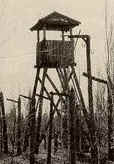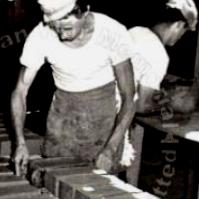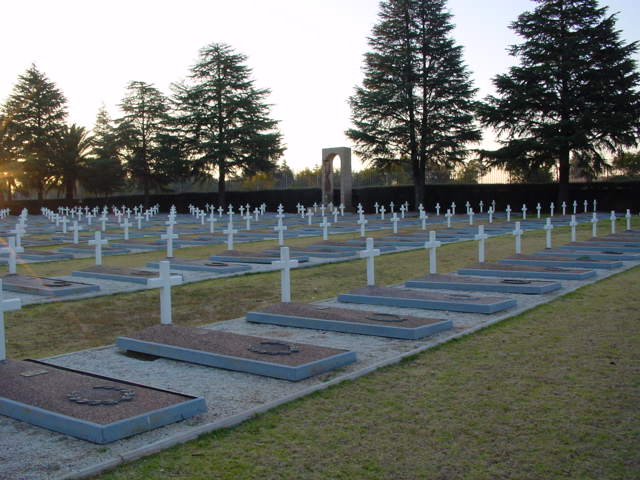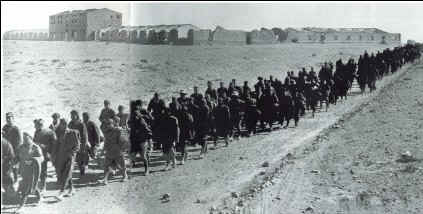|
PRIGIONIERI AFRICA AUSTRALE SUD AFRICA E RHODESIA Da campo di prigionia a trampolino per l'integrazione |
|
|
| In ogni capoverso una breve traduzione riassunto | Zonderwater: | |
|
|
The crucial event which led to the massive increase in the numbers of Italian settlers in this country was the Second World War. On the 11th June 1940, after Rome's entry into the war against London, the Smuts Government of South Africa, allied to England, declared open hostilities against Italy. For the Italian community resident in the country, it was the beginning of a difficult period as it became the object of hostile public opinion. Various concentration camps were opened in the territory for the internment of the civilian population of the enemy nations, among them Italy and Germany. About 800 Italians were interned. The largest group was at Koffiefontein in the Orange Free State, together with Germans and Afrikaners. Dopo la dichiarazione di guerra contro l'Inghilterra anche il Sud Africa suo alleato ce la dichiara. Internamento degli immigrati di origine italiana e tedesca, compresi gli Afrikaner a vari campi: il maggiore Koffiefontein | |
|
Nel testo a fianco e nei link lasciamo che siano gli stessi testimoni a raccontare quel periodo. Nel 1941 cominciarono ad affluire a Zonderwater, una conca a cinquanta chilometri ad est di Pretoria, i primi prigionieri di guerra italiani catturati. Gli arrivi si susseguirono per tutta la durata della guerra ed ebbero un incremento massiccio dopo la sconfitta di El Alamein. Alla fine si contarono quasi 70.000 soldati. I prigionieri non ebbero certo vita agiata, ma tutti sono concordi nel riconoscere che furono trattati con umanità e che il comandante inglese fece di tutto per alleviarne le loro sofferenze. Non solo qui ma anche nella vicina Rodesia vennero inviati prigionieri dopo El Alamein. La consistenza dei reclusi aveva fatto esplodere anche qui il problema immediato dell’alimentazione e le 1300 calorie giornaliere (come da convenzione di Ginevra) vennero per molto tempo integrate con arachidi (500 gr. a testa, quello che era rimasto nei magazzini della sussistenza). Non avevano previsto che avrebbero catturato così tanta gente e diventò per loro un problema molto serio. Molti italiani si distinsero per la loro abilità e genialità, costruendo case, impiantando nuovi modelli agricoli, creando opere d'arte. Nacque un rapporto di fiducia che a guerra finita, indusse molti a restare, con le relative mogli sud africane. Oggi si contano a migliaia i sudafricani di origine italiana, figli e nipoti dei vecchi prigionieri (chiamati anche Boeri italiani). Il campo di Zonderwater non esiste più. In un piccolo settore del suo territorio è stato eretto un cimitero per gli italiani che morirono durante la prigionia: poco più di duecento. Il cimitero-mausoleo è curato con i fondi del Ministero della difesa italiano da un gruppo di italiani sudafricani che lo gestisce esponendo oggetti risalenti al tempo della prigionia |
After the first victories of the Allied Forces in East Africa during the first half of 1941, Italian prisoners-of-war began to arrive in South Africa. The number grew relentlessly in a short time: 54.000 in April 1942, 63.000 in 1943....The barbed wire enclosed area, situated 40 km. from Pretoria on a vast and arid plain, characterised by an immense expanse of conical tents to house the prisoners, soon became the largest Allied concentration camp of the Second World War: "Zonderwater" meaning "place of no water".
 Zonderwater became a real prison-city and grew to accommodate up to 90.000 prisoners. The camp was divided into 14 blocks, each block into four sub-camps, each of which could house 2000
men. Nell’arida piana si estese l’attendamento più grande del mondo. 14 blocchi divisi a loro volta in 4 campi da 2.000 uomini circa cadauno per un totale di quasi 100.000 prigionieri
(anche qui le cifre ufficiali parlano di un primo contingente che è
meno della metà, incrementato dopo il maggio 1943 con uomini presi in
Africa Orientale e medio oriente) Zonderwater became a real prison-city and grew to accommodate up to 90.000 prisoners. The camp was divided into 14 blocks, each block into four sub-camps, each of which could house 2000
men. Nell’arida piana si estese l’attendamento più grande del mondo. 14 blocchi divisi a loro volta in 4 campi da 2.000 uomini circa cadauno per un totale di quasi 100.000 prigionieri
(anche qui le cifre ufficiali parlano di un primo contingente che è
meno della metà, incrementato dopo il maggio 1943 con uomini presi in
Africa Orientale e medio oriente)Infrastructures arose to make life easier and better organised for the prisoners. Thanks to the humanity of the camp commander, Colonel Prinsloo, and the initiative of the prisoners, hospitals, sport fields, chapels, theatres and schools were provided at Zonderwater. In the desolate landscape of war, it was the ability of the Italian prisoners to sustain spiritual activities that raised their morale. Together with these, their creation and production of material necessities made Zonderwater a unique experience. A testimony of humanity and survival. There is to this day tangible proof and vivid reminders of the work undertaken by these people. The chapel at Pietermaritzburg, the church of San Collegio in Middelburg, the road carved out of rock between Paarl and Worcester, Vaal Drive along the Cape coast, the Orange River irrigation scheme at Upington, bridges and many more difficult and arduous projects. |
|
|
|
The latent talent of the prisoners was recognised by the authorities, and with the help of the Pretoria and Johannesburg Italian communities, the necessary tools and equipment were supplied to enable the prisoners to work and therefore keep up their morale and remain in touch with reality. The handicrafts produced were of such a high standard that exhibitions were organised both in and out of the camp. These crafts included toys, carved wooden boxes, bedroom suites - one was sold to a civilian for 400 pounds - dining room suites, wrought iron work, etc.,etc.,etc. Art was encouraged and many beautiful sculptures and paintings were created. There was a drama department which produced spectacular musicals and plays. Naturally, musicians were available in large quantities and once the instruments had been found, there was no stopping them. A magazine was written and edited every week so as to keep everyone informed as to the happenings throughout the camp. Poiché non mancavano musicisti ed artisti si assistette alla costruzione di giocattoli, mobili, sculture e intaglio in legno e naturalmente alla messa in scena di commedie e orchestre con strumenti reperiti fuori dal campo. | |
|
British took hundreds of thousands of Italian POW's. Shipping was always short. They stuck them everywhere from Ethiopia to Arabia. Rhodies offer to take them all. Claim they need more European workers - treat them halfway decently and many stay after the war and send for their families. Pow in Canada. Giamaica e Aden 139, Rhodesia 4471, Malta 726, Gibilterra 541
dove trovare altre notizie http://rapidttp.com/milhist/vol014lb.html e 1011jb relazione medica sud africa diario www.diariodiunprigioniero.it
in Italiano (Lodigiano) in Sud Africa |
Intervento del Presidente della Repubblica Carlo Azeglio Ciampi in visita di Stato in Sud Africa
In questa quiete, in questa campagna verde è difficile immaginare i rigori di un campo di prigionia: la vita quotidiana, la nostalgia, i disagi, le ansie e le angosce dei centomila prigionieri di guerra italiani che furono internati a Zonderwater dal 1943 al 1946; o le loro piccole gioie: la corrispondenza ricevuta, le amicizie, le attività sportive e culturali con cui si ingegnavano per impiegare il tempo libero; o la grande gioia della fine della guerra, della liberazione, del ritorno in patria. Saluto e ringrazio della loro presenza con noi il gruppo degli ex-prigionieri. Solo chi è stato qui prigioniero può rivedere e rivivere. Noi ci limitiamo a rendere loro onore e a conservare la memoria del loro sacrificio. |
|
| Some 9,000 analphabete peasants learned to read and write Italian. 9.000 analfabeti impararono a leggere e scrivere. Some 15 schools were established and maintained in the Blocks, the average attendance during the scholastic year having been 10,000 pupils. 15 scuole vennero mantenute per il completamente degli studi. A central library containing over 10,000 volumes was maintained, while each Block had its individual branch library. Cinema shows and radio diffusion were regular and popular features in all the Blocks. Una biblioteca da 10.000 volumi, cinema e radio erano attive nel campo e nei sottocampi. The total number of prisoners held in South Africa was 67,000 (at 31st December, 1942). Two hundred and thirty-three P.O.W. died in captivity (from illness). Seventy-six P.O.W. died in captivity (from accidents). These two figures combined represent a little more than half of one per cent of the total P.O.W. held in South Africa. 233 prigionieri morirono di malattia e 76 in incidenti, (che sono meno del 1% del totale). |
Put in a nutshell, Zonderwater became a town with all the infrastructures necessary for survival. From May 1945, the gradual repatriation of the prisoners began. It ended two years later when the prisoner-of-war camp was dismantled. About 800 prisoners were granted permission to stay in South Africa. Precisely because of the Zonderwater experience, a new relationship between Italy and South Africa was born. The repatriated ex prisoners-of-war paved the way for a consistent migratory flow of Italians to South Africa in the fifties, from whom the present Italian community draws it's characters. Some 20.000 ex prisoners returned to South Africa within a few years. Very many illustrious persons have not been mentioned in this brief profile. To them, we salute you and thank you all for your tenacity and for the legacy you have left us. A cornucopia of food and fashion and intelligence. A passion for life and all things beautiful. A tradition of family values and perseverance. With the culture of centuries behind us, we Italians shall hold our heads up high and continue to give of our best in every sphere of life, as we have done in the past. The Italians in South Africa were all entrepreneurs in one way or another and they will always be mentioned in books of historical interest because of their great contribution towards the building of this glorious country.
I rientri, conclusi nel 47, non ebbero luogo per 800 persone autorizzata e restare subito. Altre 20.000 tornarono dopo pochi anni e sono alla base della attuale comunità molto inserita nel commercio e nell’industria. |


